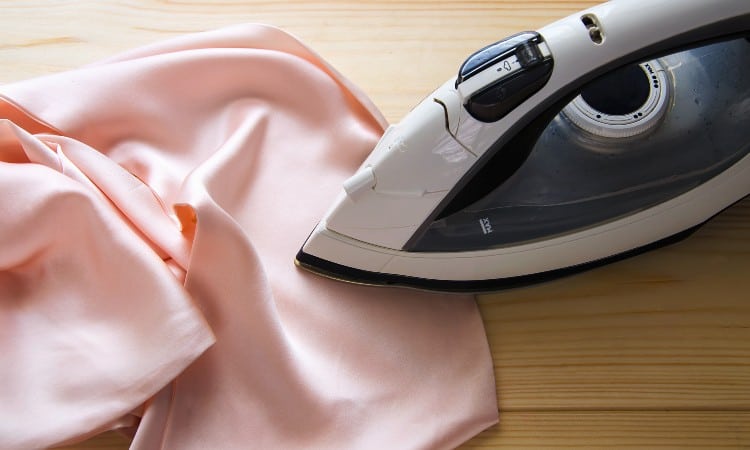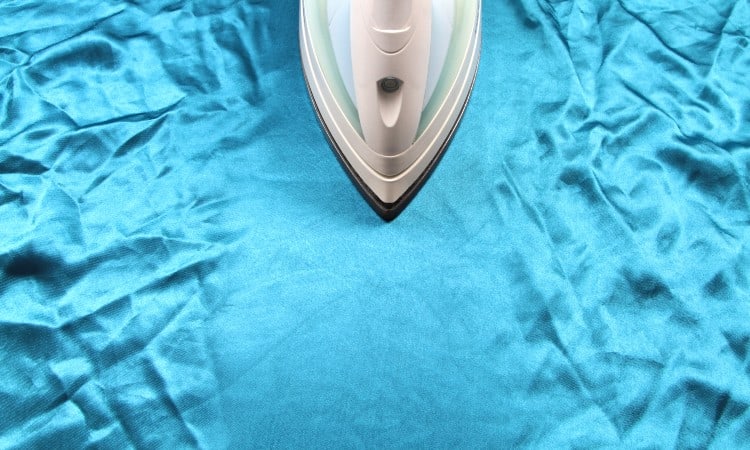While beautiful, luxuriant, and strong, silk is also delicate and easily wrinkled. Can you iron silk without damaging it? Do you have to iron silk, or are there other methods to remove wrinkles? Silk is expensive; is it better to take silk to a professional to have it laundered and pressed?
With care and proper technique, silk garments can be ironed at homewithout paying professionals. Depending on the extent of wrinkling, ironing may not even be needed. Successful methods include steaming, misting/hanging, and direct ironing.
In this article, we’ll discuss methods to iron, straighten or otherwise wrestle this magnificent material from a wrinkled wad to a crisp shimmering state. You’ll learn the skills necessary to iron silk without burning the garment, identify light, moderate, and heavy wrinkles, and which techniques you should use before others.

Quick Navigation
Can You Iron Silk?
You can iron silk, but is it necessary? It depends on the extent of the wrinkling. If the silk has only light wrinkle lines, possibly from being stored/folded incorrectly, you could spritz the garment with water, leave it on a hanger, and the wrinkles will smooth out by themselves in a few hours.
If you live in a hot, humid environment, consider hanging your silk garments outside to good effect. If this isn’t an option, place your silk garment on a hanger in the bathroom and take a hot shower. These options will smooth minor wrinkles with minimal effort.
If the silk has moderate wrinkles from being folded correctly, but spending extensive time in a suitcase. You might consider this steaming technique by placing the garment on a hanger, setting an iron to high steam, and carefully passing the iron an inch or two above the garment, resulting in a beautifully smooth product.
Heavy wrinkles can be caused by everyday wear, incorrect washing, or unintentional neglect. Heavy wrinkles will need ironing and may require multiple iron/resting sessions, depending on the extent of wrinkling. If it’s obvious the garment will need multiple sessions, DO NOT attempt to “fix” it in a single session with more heat, pressure, and elbow grease. You will ruin the garment; heavy wrinkles still need a light touch and will require two to three sessions.
What Temperature Should You Iron Silk?
Your iron should always be set on the lowest possible heat setting, and you should never keep the iron in one place for very long. You may need to turn the heat up (slightly) but always start at the lowest heat setting; silk burns surprisingly fast, and once burned, it can’t be repaired. If this is your first time ironing a silk garment, use either a small piece you’re not attached to or test your skills on a damaged (or well-worn) blouse.
Best Iron Setting for Silk
Some irons have a “Silk Setting,” if yours doesn’t, use the lowest heat option. Some specialty irons come from the manufacturer with an “Iron Sole” attachment to make ironing silk and satin materials easier. If you don’t possess an “Iron Sole,” consider purchasing one here.
How To Iron Silk Step-By-Step

Silk with moderate to heavy wrinkles should be ironed and, depending on the severity, may require multiple iron/resting sessions.
- Turn the silk garment inside out. Always iron silk from the “dull” inside (which is tougher and more forgiving), not the shiny outside (which is delicate and less forgiving).
- Using a spray bottle, generously dampen the garment. You want more steam than heat because it’s the steam that does work. Adjust the water application as needed. You’ll need to experiment with the dampness suitable to your preference.
- Use the “Silk Heat Setting” on your iron; if your iron doesn’t have this setting, use the lowest heat option. As you iron, you may need to turn the heat up (slightly) but always start at the lowest heat setting.
- Place an ironing cloth (this can be anything from a rag, bandana, or thin towel) over the dampened silk garment. Don’t allow the silk to have direct contact with the iron, or the silk will burn.
- There are a few contradictory schools of thought when ironing silk, but the best options seem to be the following:
- Kissing the Silk
With no motion, simply set the iron straight down. Press the iron with very little movement, then lift the iron. The iron shouldn’t have any prolonged contact with the garment. Press and lift, press and lift, etc. Of the two recommended techniques, this is the most careful.
- Snuggling the Silk
Place the iron on the ironing cloth, make a few small circular motions, then immediately lift the iron off the garment. The iron should stay in constant motion, the circles should be small, and there shouldn’t be prolonged contact. Check the area, adjust the garment on the ironing board as necessary and continue.
- Use the iron tip for delicate or frilly sections (like narrow sleeves, pockets, or skirt frills).
- Hang the silk garment in a cool, dry closet to finish drying.
- Repeat these steps for deep or stubborn wrinkles (dampen, iron, rest) a few times.
How to Stop Silk From Wrinkling
Silk Naturally Wrinkles – Silk Will Be Silk
Silk is a natural protein fiber produced by silkworms and it wrinkles very easily. Even leaving a lightly rumpled garment on a bed or draped over a chair can cause wrinkles. While some silks like Ahimsa, Noil, and Charmeuse, are less prone to wrinkling, all silks are delicate. There is no such thing as “wrinkle-free” silk.
Traveling with Silk Garments
When traveling, hang your silk garments in garment bags. This will help protect them from dust, creasing, and wrinkles, but this is not a catch-all. Your silk dress is less likely to wrinkle but not guaranteed not to. It doesn’t matter how nice or expensive the garment bag is; silk may still find a way to wrinkle.
Folding and Storing Silk Garments
Avoid storing silk garments in sealed plastic containers as the material is organic and needs to “breath.” If you’re folding silk clothes for storage, another material is typically used as a liner. Store your silks individually in a breathable cotton bag or layered with cotton fabric. Silk should be stored in a cool, dry, and dark location as sunlight can quickly cause discoloring.
Conclusion
Anyone can iron silk at home with a bit of practice, and it’s such a useful skill! Just remember to dampen the silk with a spray bottle, use the lowest heat setting, use an iron cloth, keep iron contact with the silk minimal, and always keep the iron in motion. I hope you’ve enjoyed this article If you have any questions, please leave a comment and share the article with your friends!